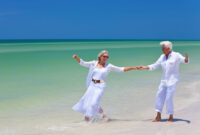Senior Tours Cruises offer a unique blend of relaxation, exploration, and camaraderie, catering to the specific needs and desires of older travelers. This guide delves into the diverse world of senior-focused travel, examining everything from the ideal traveler profile and various trip types to accessibility considerations, marketing strategies, and crucial safety protocols. We’ll explore the nuances of pricing, value propositions, and the overall experience to help you understand this growing market segment.
Whether you’re a travel agency specializing in senior travel, a cruise line seeking to enhance your offerings, or simply an individual curious about this niche market, this comprehensive overview will provide valuable insights and actionable information. We will cover the unique challenges and opportunities presented by this demographic, offering practical strategies for success in the senior travel sector.
Target Audience for Senior Tours and Cruises
The ideal demographic for senior tours and cruises encompasses a broad range of individuals, united by a shared desire for enriching travel experiences but diverse in their specific needs and preferences. Understanding this diversity is crucial for tailoring successful and fulfilling travel packages.
Senior travelers represent a significant and growing market segment, with a wide spectrum of ages, activity levels, and financial capabilities. This necessitates a nuanced approach to marketing and service provision, moving beyond simplistic generalizations.
Demographic Profile of the Ideal Senior Traveler
The typical senior interested in tours and cruises is likely to be aged 65 and above, though many active individuals begin exploring these options earlier. They often possess a degree of financial security, allowing them to invest in travel experiences. Many are retired or semi-retired, giving them the flexibility to embark on longer trips. A significant portion are couples traveling together, while others may be solo travelers or part of small groups of friends. Educational attainment is often high, indicating a preference for enriching and culturally stimulating itineraries.
Varying Needs and Preferences within the Senior Traveler Demographic
Significant variations exist within this demographic. Health concerns are paramount. Some seniors may have limited mobility, requiring accessible accommodations and itineraries with minimal strenuous activity. Others maintain high levels of fitness and seek adventurous excursions. Budgetary constraints also vary widely, from those seeking luxurious, all-inclusive experiences to those prioritizing value and affordability. Travel styles differ significantly; some prefer structured tours with guided excursions and pre-arranged activities, while others prefer independent exploration and a more flexible itinerary. Dietary restrictions and preferences are also crucial considerations, as are specific needs related to medication management or accessibility to healthcare services.
Motivations for Choosing Tours and Cruises
Senior travelers are motivated by a variety of factors. A primary driver is the desire for relaxation and rejuvenation, escaping the daily routines of life and enjoying a period of rest and recreation. Many seek enriching cultural experiences, visiting historical sites, museums, and experiencing different cultures firsthand. The convenience and all-inclusive nature of many tours and cruises are also significant attractions, eliminating the stress of planning and logistics. Social interaction is another key motivator, with many seniors enjoying the opportunity to meet new people and share experiences with like-minded individuals. Finally, the opportunity to create lasting memories and revisit places of significance is a strong impetus for many senior travelers. For example, a couple celebrating their 50th wedding anniversary might choose a luxurious cruise to the Caribbean, while a group of friends might opt for a guided tour of Europe focusing on historical landmarks.
Types of Senior-Friendly Tours and Cruises
Choosing the right travel experience is crucial for seniors, ensuring comfort, accessibility, and enjoyment. This section details the various types of senior-friendly tours and cruises available, helping you find the perfect fit for your needs and preferences. We’ll explore different cruise lines, itineraries, and land-based tours designed with the specific requirements of older travelers in mind.
Senior-Friendly Cruise Lines and Tour Operators
Several cruise lines and tour operators cater specifically to the needs and preferences of senior travelers. These companies often offer amenities and services designed to enhance the travel experience for older adults, including accessible cabins, specialized shore excursions, and onboard activities tailored to their interests and physical capabilities. Examples include Oceania Cruises, known for its upscale, sophisticated voyages with enriching onboard programs, and Viking Ocean Cruises, which emphasizes cultural immersion and enriching experiences. For land-based tours, companies like Trafalgar and Globus specialize in escorted tours with comfortable pacing and attention to detail for older travelers. These operators often provide assistance with luggage, pre-arranged transportation, and easy-to-navigate itineraries.
Cruise Itineraries Designed for Seniors
Cruise itineraries for seniors often prioritize shorter voyages, minimizing potential fatigue and maximizing enjoyment. Many cruises specifically cater to older travelers by offering shorter durations (7-10 days), eliminating excessively long travel days. Accessibility is another key feature, with many lines offering accessible cabins and shore excursions designed to accommodate various mobility levels. Furthermore, many itineraries focus on destinations with easier navigation and fewer strenuous activities. For example, a Caribbean cruise might focus on ports with readily accessible docks and flat terrain, reducing the need for extensive walking. Alternatively, a river cruise along the Rhine or Danube could provide a relaxing and scenic journey with minimal physical exertion.
Examples of Land-Based Tours Tailored to Seniors
Land-based tours also offer excellent options for senior travelers, often focusing on manageable paces and enriching experiences. These tours typically feature comfortable accommodations, convenient transportation, and well-planned itineraries that cater to different interests and physical abilities.
| Tour Name | Destination | Duration | Special Features |
|---|---|---|---|
| Classic Italy Tour | Italy (Rome, Florence, Venice) | 10 days | Private transportation, guided walking tours with manageable distances, optional rest days, comfortable hotel accommodations. |
| Canadian Rockies Rail Journey | Canadian Rockies (Banff, Jasper, Lake Louise) | 7 days | Scenic train travel, accessible accommodations, shorter excursions with options for varied activity levels, emphasis on stunning scenery. |
| National Parks of the Southwest | USA (Grand Canyon, Zion, Bryce Canyon) | 14 days | Accessible transportation, shorter hiking trails with varied difficulty levels, comfortable lodging near park entrances, emphasis on natural beauty and cultural experiences. |
| Coastal California Adventure | California (San Francisco, Monterey, Carmel) | 8 days | Accessible transportation, scenic drives with stops at points of interest, comfortable accommodations, options for varied activity levels, emphasis on coastal scenery and charming towns. |
Accessibility and Inclusivity
Ensuring a comfortable and enjoyable travel experience for all senior travelers is paramount. This requires a proactive approach to accessibility and inclusivity, encompassing various aspects of the journey, from embarkation to shore excursions. Addressing the unique needs of seniors with varying levels of mobility and health conditions is crucial for creating a truly welcoming and memorable experience.
Accessibility features on ships and at tour locations are vital for seniors with mobility limitations. The availability of ramps, elevators, wider doorways, and well-maintained pathways significantly enhances their ability to navigate the ship and explore destinations independently. Furthermore, the provision of accessible cabins with adaptable bathrooms and grab bars ensures comfort and safety. Shore excursions should also be carefully planned to minimize strenuous activities and provide options for those with limited mobility, perhaps offering alternative transportation or routes. For example, a tour of a historical site might include accessible entrances and pathways, and perhaps offer a shorter, less strenuous route for those who need it.
Onboard Medical Facilities and Support Services for Seniors
Ships catering to senior travelers should have well-equipped medical facilities staffed by qualified medical professionals. The availability of 24-hour medical services provides peace of mind and ensures prompt attention in case of medical emergencies. Support services such as assistance with medication management, mobility aids, and personalized care plans are also essential. Many cruise lines offer pre-boarding medical consultations to assess individual needs and create customized plans. For example, a passenger with diabetes might receive assistance with blood sugar monitoring and dietary management throughout the cruise. The presence of trained personnel familiar with geriatric care further enhances the safety and well-being of senior passengers.
Procedures for Handling Special Dietary Needs and Medical Emergencies
Catering to diverse dietary requirements is crucial for senior travelers. Many seniors have specific dietary restrictions due to allergies, medical conditions, or personal preferences. Cruise lines and tour operators should have clear procedures for handling special dietary requests, including vegetarian, vegan, gluten-free, and other specialized diets. Detailed dietary information should be collected during the booking process and communicated to the onboard catering staff to ensure accurate meal preparation. In case of a medical emergency, well-defined protocols are necessary for prompt and effective response. This includes procedures for contacting emergency medical services, providing first aid, and facilitating transportation to medical facilities. Regular drills and training for staff members on handling medical emergencies are vital to ensure preparedness and efficiency in response. For instance, a clear communication protocol between the ship’s medical staff and shore-based emergency services should be established and regularly tested.
Marketing and Promotion Strategies
Reaching the senior travel market requires a nuanced approach that acknowledges their preferences and needs. Effective marketing hinges on clear communication, visually appealing materials, and targeted outreach to relevant communities. This section outlines strategies for designing compelling marketing materials and engaging directly with senior audiences.
Marketing Material Design for Senior Travelers
Marketing materials for senior travelers should prioritize readability and ease of understanding. Brochures and website copy should utilize large, clear fonts (at least 12-point), ample white space, and a straightforward layout. Avoid cluttered designs or small print. Information should be presented concisely and logically, focusing on key benefits and addressing potential concerns (e.g., accessibility, health considerations). The language used should be respectful and avoid overly casual or trendy terms. Website navigation should be intuitive and easy to use, with clear calls to action (e.g., “Book Now,” “Request a Brochure”).
Compelling Visuals and Descriptions for Advertising
Visuals play a crucial role in attracting senior travelers. Photographs and videos should depict active, engaged seniors enjoying the tours and cruises. Images should be high-quality, well-lit, and showcase the destinations’ beauty and unique features. Color palettes should be calming and sophisticated, favoring earth tones, blues, and greens. Avoid overly bright or jarring colors. For example, a brochure showcasing a European river cruise might feature a serene image of a senior couple enjoying a glass of wine on a sun-drenched deck, overlooking a picturesque vineyard. The accompanying text could highlight the relaxed pace of the cruise, the opportunity for cultural immersion, and the ease of accessibility. Another example could be a vibrant image of a group of seniors laughing together while participating in a guided tour of a historical site, showcasing the social aspect of the trip. The accompanying text could emphasize the camaraderie and shared experiences.
Outreach Strategies to Senior Communities
Direct engagement with senior communities is essential for successful marketing. This involves establishing relationships with senior centers, retirement homes, and retirement communities. Strategies include:
- Presenting informative sessions at senior centers about upcoming tours and cruises, highlighting relevant features like accessible accommodations and planned excursions.
- Distributing brochures and flyers at retirement homes and senior living facilities, ensuring materials are easy to read and understand.
- Partnering with local organizations that serve senior citizens to offer exclusive discounts or promotions.
- Utilizing targeted online advertising on websites and social media platforms frequented by seniors, such as AARP or Facebook groups dedicated to retirement communities.
- Collaborating with travel agents specializing in senior travel to reach a wider audience.
These strategies aim to build trust and credibility within the senior community, demonstrating a genuine commitment to their needs and preferences.
Pricing and Value Proposition
Pricing transparency and a clear value proposition are crucial for attracting senior travelers. Understanding the various pricing models and factors influencing cost allows tour operators to create packages that resonate with this demographic’s needs and budgets. A well-defined value proposition emphasizes the unique benefits and exceptional experiences offered, justifying the price point and fostering customer confidence.
Pricing models for senior tour and cruise packages vary significantly. Some operators offer all-inclusive packages, encompassing flights, accommodation, excursions, and meals, while others adopt a modular approach, allowing seniors to customize their trip by selecting individual components. All-inclusive packages often provide better value for money, especially for longer trips, while modular packages offer flexibility and cost control for budget-conscious travelers. Luxury cruise lines typically employ a tiered pricing system based on cabin class and amenities, while budget-friendly options focus on affordability without compromising essential services. River cruises often feature inclusive pricing models that include excursions and onboard amenities.
Factors Influencing Pricing of Senior-Focused Travel Options
Several key factors contribute to the pricing of senior-focused travel options. These include the destination’s popularity and accessibility, the length of the trip, the level of accommodation (e.g., luxury hotels versus budget-friendly options), the inclusion of excursions and activities, the transportation method (e.g., airfare, coach travel, private car), and the level of personalized service provided. For example, a guided tour of Europe with private transportation and high-end hotels will naturally command a higher price than a group tour with budget accommodations and public transportation. The seasonality of travel also plays a crucial role; peak seasons often see increased prices. Furthermore, insurance costs, which may be higher for older travelers, can also affect overall package pricing. Discounts for seniors are frequently offered, but these vary depending on the tour operator and the time of year.
Creating a Compelling Value Proposition for Senior Tours and Cruises
A compelling value proposition for senior travel should emphasize the unique benefits and experiences tailored to the needs and preferences of this demographic. This goes beyond simply offering a discount; it’s about showcasing the value received. For example, a value proposition might highlight: “Experience the charm of Italy without the stress: our all-inclusive tour features comfortable accommodations, expert-led excursions, and convenient transportation, allowing you to fully immerse yourself in Italian culture without the hassle of planning.” Another might focus on: “Relax and rejuvenate on our Caribbean cruise: Enjoy spacious cabins, exceptional dining, and a wide range of onboard amenities designed for your comfort and well-being.” Highlighting aspects like ease of travel, comfortable accommodations, accessible facilities, and engaging activities catered to senior interests will resonate with the target audience. Emphasizing stress-free travel and enriching experiences are vital components of a successful value proposition. Using testimonials from satisfied senior travelers further enhances credibility and persuasiveness.
Last Recap
Ultimately, the success of senior tours and cruises hinges on understanding the specific needs and desires of this demographic. By prioritizing accessibility, safety, and a well-crafted value proposition, travel providers can create memorable and enriching experiences that cater to the unique preferences of older travelers. This approach not only ensures customer satisfaction but also fosters a thriving and sustainable business model within the increasingly popular senior travel market. Careful planning, attention to detail, and a genuine commitment to providing exceptional service are key to success in this rewarding niche.




